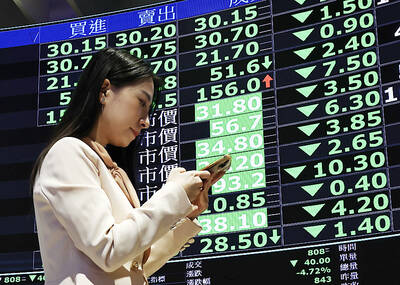Local chip designer Faraday Technology Corp (智原科技) yesterday posted a net profit of NT$146 million (US$4.78 million) for last quarter, a quarter-on-quarter increase of 160.71 percent thanks to strong demand for application-specific ICs used in smart meters, networking products and 5G small cells.
On an annual basis, net profit surged 67.82 percent from NT$87 million, while earnings per share rose to NT$0.59 from NT$0.22 a quarter earlier and NT$0.35 a year earlier.
The Hsinchu-based company expects revenue this quarter to fall by a single-digit percentage from last quarter’s NT$1.59 billion, the highest level in 13 quarters.
However, it still expects to register annual growth in revenue, Faraday chief financial officer Grace Tseng (曾雯如) said.
Gross margin is to remain at about 50 percent this quarter, compared with 50.4 percent last quarter, Tseng said, attributing the slight decline to non-recurring engineering (NRE) services on 14-nanometer technology.
The company is collaborating with Samsung Electronics Co to provide 14-nanometer chips.
Faraday president Steve Wang (王國雍) said that he is optimistic about next year, as customers are accelerating the pace of the design to the mass-production process.
In addition, the company is benefiting from the US-China trade dispute, Wang said.
As China builds its own chip manufacturing capabilities and reduces its dependence on US firms, the company has seen an increase in orders, he said.
Most chips designed in the past one or two years are entering the final stages of verification and are to enter mass production next year, he added.
Faraday charges royalty fees for the chips it designs for clients, mostly after they enter mass production. That royalty income is the firm’s biggest source of revenue, providing 59 percent last quarter.
“Growth momentum from smart meters is to carry into next year. Chinese customers are showing strong demand,” Wang said.
Faraday can leverage foundry capacity in China from its parent company, United Microelectronics Corp (UMC, 聯電), Wang added.
In addition, the company expects chips for artificial intelligence Internet of Things apps and enterprise solid-state drives to start contributing next year, he added.
Revenue from the NRE and intellectual property rights businesses would hit a new high this year, extending record growth in the third quarter, Wang said.
NRE contributed 26 percent of the company’s revenue last quarter, Faraday said, adding that most NRE services utilize relatively advanced 40-nanometer and 28-nanometer technologies.
The intellectual property rights business accounted for 14.6 percent of third-quarter revenue, it said.

TARIFFS: The global ‘panic atmosphere remains strong,’ and foreign investors have continued to sell their holdings since the start of the year, the Ministry of Finance said The government yesterday authorized the activation of its NT$500 billion (US$15.15 billion) National Stabilization Fund (NSF) to prop up the local stock market after two days of sharp falls in reaction to US President Donald Trump’s new import tariffs. The Ministry of Finance said in a statement after the market close that the steering committee of the fund had been given the go-ahead to intervene in the market to bolster Taiwanese shares in a time of crisis. The fund has been authorized to use its assets “to carry out market stabilization tasks as appropriate to maintain the stability of Taiwan’s

STEEP DECLINE: Yesterday’s drop was the third-steepest in its history, the steepest being Monday’s drop in the wake of the tariff announcement on Wednesday last week Taiwanese stocks continued their heavy sell-off yesterday, as concerns over US tariffs and unwinding of leveraged bets weighed on the market. The benchmark TAIEX plunged 1,068.19 points, or 5.79 percent, to 17,391.76, notching the biggest drop among Asian peers as it hit a 15-month low. The decline came even after the government on late Tuesday authorized the NT$500 billion (US$15.2 billion) National Stabilization Fund (國安基金) to step in to buoy the market amid investors’ worries over tariffs imposed by US President Donald Trump. Yesterday’s decline was the third-steepest in its history, trailing only the declines of 2,065.87 points on Monday and

TARIFF CONCERNS: The chipmaker cited global uncertainty from US tariffs and a weakening economic outlook, but said its Singapore expansion remains on track Vanguard International Semiconductor Corp (世界先進), a foundry service provider specializing in producing power management and display driver chips, yesterday withdrew its full-year revenue projection of moderate growth for this year, as escalating US tariff tensions raised uncertainty and concern about a potential economic recession. The Hsinchu-based chipmaker in February said revenues this year would grow mildly from last year based on improving supply chain inventory levels and market demand. At the time, it also anticipated gradual quarter revenue growth. However, the US’ sweeping tariff policy has upended the industry’s supply chains and weakened economic prospects for the world economy, it said. “Now

Six years ago, LVMH’s billionaire CEO Bernard Arnault and US President Donald Trump cut the blue ribbon on a factory in rural Texas that would make designer handbags for Louis Vuitton, one of the world’s best-known luxury brands. However, since the high-profile opening, the factory has faced a host of problems limiting production, 11 former Louis Vuitton employees said. The site has consistently ranked among the worst-performing for Louis Vuitton globally, “significantly” underperforming other facilities, said three former Louis Vuitton workers and a senior industry source, who cited internal rankings shared with staff. The plant’s problems — which have not